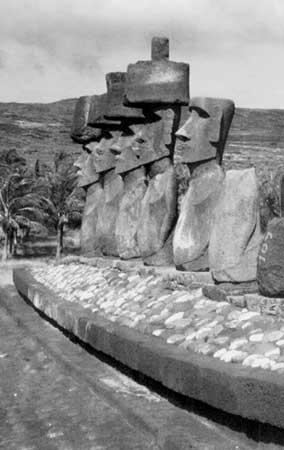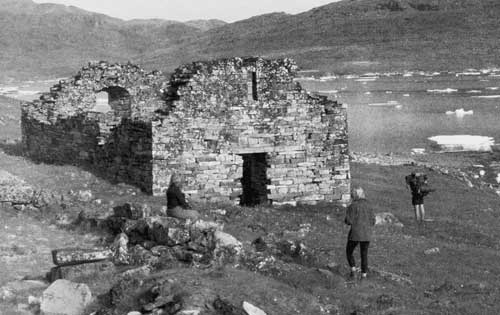
This Article From Issue
March-April 2005
Volume 93, Number 2
DOI: 10.1511/2005.52.0
(Also see our online interview with Jared Diamond regarding this book.)
Collapse: How Societies Choose to Fail or Succeed. Jared Diamond. xvi + 576 pp. Viking, 2005. $29.95.
Convinced that the world is in big environmental trouble, Jared Diamond offers readers a hefty tome that looks to the past to help us face the future. A fuller title, Diamond says, would be "Societal collapses involving an environmental component, and in some cases also contributions of climate change, hostile neighbors, and trade partners, plus questions of societal responses." Several societies in the past have collapsed in part because of environmental overexploitation, whereas others, despite similar overexploitation, have survived. What makes the difference between collapse and survival? Diamond argues that by examining the environmental problems of past societies and analyzing how they either escaped or succumbed to them, we can learn useful lessons for our own times. In this way he aims to help us recognize the seriousness of the planet's environmental condition and to provide what historians sometimes call "a usable past," so as to raise the chances that we can rescue the situation and avoid a very unpleasant fate, the mother of all collapses.
Combing the past for episodes that provide salutary lessons for the present is something historians, and others, have done for ages, but more often in international relations than in other realms of human endeavor. Environmental historians (a small but rapidly growing subset of historians and like-minded scholars in other disciplines) have normally resisted this urge, but then they typically work on projects of such small scale that drawing parallels or lessons becomes surpassingly difficult.
The scope of Diamond's project is sprawling. He roams over the entire planet and across millennia, as he did in his Pulitzer-prizewinning bestseller, Guns, Germs, and Steel. The method employed in the two books is similar, as he explicitly notes. By comparing the environmental histories of several societies that either did or did not collapse, and by examining what he calls "input variables"—of which more below—he aims to "tease out the influence of possible input variables on collapses."
The variables Diamond refers to are five considerations that together he calls a "five-point framework" for analyzing the environmental evolution of societies: the degree and nature of environmental damage; the degree and nature of climate change; the level of hostility of neighboring societies; the degree of reliance on friendly trading partners; and the nature of a society's responses to its environmental problems. In offering this framework, Diamond goes beyond simplistic formulations about ecological collapse, recognizing that environmental deterioration always operates as a force among other forces, and sometimes in synergistic conjunction with other forces. Historians and social scientists will probably see the framework as imperfect for its neglect of other variables—which are legion—that can contribute to societal collapses. But a complete roster of potentially relevant variables leads to an unworkably complex model, and Diamond's has the virtue of simplicity.

From Collapse
The framework shapes his presentation of Parts I and II of the book, which consist of case studies of Montana, Easter Island, Pitcairn and Henderson Islands, the Anasazi of Chaco Canyon, the Classic Maya, the Norse in Iceland and Greenland, the New Guinea highlands, Tikopia, and Tokugawa Japan. These treatments range in length from three chapters (for the Norse) to six pages (for highland New Guinea). They are selected for their salutary value or (for the cases of Montana and New Guinea) because Diamond liked these places and already knew something about them.
Other parts of the book ignore the five-point framework and indeed are tangential to the theme of collapse. In Part III, for example, Diamond includes chapters that review very recent environmental trends in Haiti and the Dominican Republic, China and Australia. The chapter on the two countries that make up the island of Hispaniola aims to show that similar environments can be brought to different outcomes by differing management. Here Diamond wrestles effectively with the fact that someone as unsavory as the Dominican politician Joaquín Balaguer did some good things for the environment (as did Hitler). The chapters on China and Australia are fairly orthodox summaries of current problems, leavened, especially in the case of Australia, by a wealth of anecdotes. Part III also includes a chapter on Rwanda, which emphasizes population pressure in explaining the massacres of the mid-1990s. Even the unhappy cases of Haiti and Rwanda are far from collapses in the sense that the word is used throughout the book. These four chapters almost seem like part of another book.
Part IV makes intermittent reference to the notion of collapse and the five-point framework. But it includes a 44-page chapter on good and bad environmental practices by big businesses involved in resource extraction. This chapter, although it does provide sensible explanations of why corporations behave as they do, makes no effort to address the themes of the book. Diamond's justification for including it—that corporations are important and that they are not all the same and not all bad—although true, seems insufficient. At any rate, Chevron will be happy he wrote it, whereas the defunct Canadian mining company Pegasus Gold, had it not declared bankruptcy to avoid paying environmental cleanup costs, would not.
In the end the book's structure seems a trifle ungainly, lacking the elegant proportions that helped make Guns, Germs, and Steel the success it is. But Collapse is clearly intended for the popular audience that embraced the earlier book. The writing is often reportorial, even chatty, spiced with anecdotes, asides (including half a page on Dominican baseball players), a fair bit of personal reminiscence, recounted conversations with friends and travelogue. There is not a pollen diagram or a soil-loss equation to be found. The book is written so that readers without any background in ecology or history can understand it, no mean achievement. Only rarely—in the discussion of the relevance of population to today's environmental problems, for example—did I think Diamond made matters too simple.
An accessible style can of course convey new and interesting ideas. The core ideas here are the five-point framework as a means to understand the role of environmental degradation in past societal collapses, and the relevance of the experience of ancient and low-technology societies to the modern world. The first helps ratchet up the rigor with which scholars think about the linkage, albeit from a low baseline: The propensity to explain societal collapse in environmental terms in recent decades is usually in inverse proportion to how much is known about the collapse. The five-point framework is an improvement on the breezy connections that historians have often made about the collapse of the Maya, Mycenaean Greece or the ancient civilization of the Indus Valley. I suspect that archaeologists and geographers, who by and large have been more circumspect in this department, will be less inclined to regard the five-point framework as a useful tool.
The second idea is not new. Many a scholar has suggested that the collapse of previous societies holds lessons for our own, and not a few have seized on the case of Easter Island as a suitably instructive microcosm. (The best of this genre is Paul Bahn and John Flenley's Easter Island, Earth Island [1992], updated as The Enigmas of Easter Island [2003]—a book Diamond properly relies on heavily.)
At many points Diamond argues that it is useful to consider the fates of ancient, low-tech, small-scale societies even though they were all fundamentally different from our own. He argues that with respect to the Maya, the parallel to today's societies is stronger, because they were numerous, technologically sophisticated (for their time) and sociologically complex. I am among those who believe we can learn useful lessons from the past, but I am sure many readers will remain unconvinced that knowledge of the prehistoric Polynesians or the medieval Norse carries any practical value.

From Collapse
The most convincing case for the relevance of past collapses is that of the Greenland Norse, to whom Diamond devotes two full chapters. Here he broadly follows the interpretation advanced by Thomas McGovern, according to which the settlement after some 450 years went extinct in the early 15th century because of social rigidities that prevented the Norse from adapting both to a cooler climate and to the cessation of trade links to Scandinavia—in short, rigidities that prevented them from living like the Inuit, on abundant stocks of fish, seals and whales. It is an interpretation in which the five-point framework shows its worth, although one in which actual environmental deterioration played only a modest role. These chapters are a wonderful, and to my mind convincing, account of the fate of the Greenland Norse. Here, as throughout the sections on past societies, Diamond has relied on the best authorities (mainly archaeologists) and has done his homework well.
As do most large books, this one suffers from some inconsistencies and minor inaccuracies. On page 11 the fifth point of the five-point framework is a "society's responses to its environmental problems." But on page 14 it becomes a "society's responses to its problems, whether those problems are environmental or not." Diamond writes on page 396 that Australians in the 1950s "looked fearfully at ... Indonesia with its 200 million people," but in the 1950s Indonesia had fewer than 100 million people (feared or not). And it is not (yet) the case (despite his claim to that effect on page 494) that "AIDS-affected African countries" are experiencing negative population growth. The world maps in Collapse are Mercator projections that make Greenland appear larger than South America. Writers who draw from a dozen scholarly disciplines are bound to take a few false steps, and Diamond's are small ones: None of the imperfections affects the validity of the arguments on offer.
Scholars deeply versed in the linkages between environment and society will probably find much of Diamond's work here familiar, at least in outline. They are less likely than others to be swayed by his (or anyone's) arguments, having made up their own minds already, but even they, I suspect, can find interesting and new details in almost every chapter.
But it is the general public to whom Diamond has pitched his book. Although Collapse may lack the cohesion of Guns, Germs, and Steel, Diamond's skill in making complex ideas easily accessible suggests that this book too will have a wide readership. It certainly deserves to. If it succeeds in sparking more public and political consideration of environmental difficulties, that would be welcome enough. It may well do more and bring a historical perspective, hitherto often sorely lacking, to environmental thinking, as well as raise the intellectual standard with which questions of linkages between environment and society are considered in the public sphere. That would be a rare achievement indeed.
American Scientist Comments and Discussion
To discuss our articles or comment on them, please share them and tag American Scientist on social media platforms. Here are links to our profiles on Twitter, Facebook, and LinkedIn.
If we re-share your post, we will moderate comments/discussion following our comments policy.